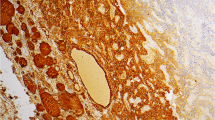Abstract
Molecular analyses of thyroid tumors have documented mutations in the tumor suppressor p53 gene almost exclusively in anaplastic carcinomas. In contrast, immunohistochemistry has localized p53 in differentiated papillary and follicular thyroid cancers. To establish the significance of p53 immunolocalization in these lesions, 78 thyroid tumors of follicular derivation were examined. All tumors were classified by strict criteria and the extent of tumor was determined morphologically. Immunohistochemical staining for p53 was performed on paraffin sections of formalin-fixed tumor tissue. The results of staining were correlated with diagnosis, tumor extent and clinical outcome. Immunopositivity for p53 was diffuse and strong in all five anaplastic carcinomas examined. There was no staining in five of six follicular adenomas. Four of nine follicular carcinomas had some degree of nuclear staining, but this was focal; all nine tumors were confined to the thyroid at the time of examination. Of 49 papillary carcinomas, 26 were intrathyroidal, and 7 of these were occult; there was no p53 positivity in any occult lesion and only 5 of the 19 palpable lesions stained. In contrast, among 23 papillary carcinomas with extrathyroidal extension or metastases, only 9 were negative for p53 immunoreactivity. Five of seven tall cell papillary carcinomas and one of two insular carcinomas had p53 immunopositivity and this correlated with aggressive behavior. These results support the tumorigenic role of p53 mutations postulated for anaplastic thyroid carcinomas and indicate that localization of p53 by immunohistochemistry is a useful prognostic index of clinical behavior in differentiated thyroid carcinomas of follicular cell derivation.
Similar content being viewed by others
References
Murray D. The thyroid gland. In: Kovacs K, Asa SL, eds. Functional endocrine pathology. Boston, MA: Blackwell Scientific, 1991; 293–374.
LiVolsi VA. Surgical pathology of the thyroid. Philadelphia, PA. Saunders, 1990.
Rosai J, Carcangiu ML, DeLellis RA. Tumors of the thyroid gland. Atlas of tumor pathology, 3rd ser, Fascicle 5, Washington, DC: Armed Forces Institute of Pathology, 1992.
Weinberg RA. Tumor suppressor genes. Science 254:1138–1146, 1991.
Levine AJ. The p53 tumor-suppressor gene. N Engl J Med 326:1350–1352, 1992.
Wynford-Thomas D. p53 in tumour pathology: can we trust immunocytochemistry? J Pathol 166:329,330, 1992.
Nigro JM, Baker SJ, Preisinger AC, Jessup JM, Hostetter R, Cleary K, Bigner SH, Davidson N, Baylin S, Devilee P, Glover T, Collins RS, Weston A, Modali R, Harris CC, Vogelstein B. Mutations in the p53 gene occur in diverse human tumour types. Nature 342:705–708, 1989.
Porter PL, Gown AM, Kramp SG, Coltrera MD. Widespread p53 overexpression in human malignant tumors. Am J Pathol 140:145–153, 1992.
Barbareschi M, Iuzzolino P, Pennella A, Allegranza A, Arrigoni G, Dalla Palma P, Doglioni C. p53 protein expression in central nervous system neoplasms. J Clin Pathol 45:583–586, 1992.
Shea CR, McNutt NScott, Volkenadt M, Lugo J, Prioleau PG, Albinot AP. Over-expression of p53 protein in basal cell carcinomas of human skin. Am J Pathol 141: 25–29, 1992.
Fagin JA. Genetic basis of endocrine disease 3. Molecular defects in thyroid gland neoplasia. J Clin Endocrinol Metab 75:1398–1400, 1992.
Farid NR, Shi Y, Zou M. Molecular basis of thyroid cancer. Endocr Rev 15:202–232, 1994.
Fagin JA, Matsuo K, Karmakar A, Chen DL, Tang S-H, Koeffler HP. High prevalence of mutations of the p53 gene in poorly differentiated human thyroid carcinomas. J Clin Invest 91:179–184, 1992.
Donghi R, Longoni A, Pilotti S, Michieli P, Della Porta G, Piarotti MA. Gene p53 mutations are restricted to poorly differentiated and undifferentiated carcinomas of the thyroid gland. J Clin Invest 91:1753–1760, 1993.
Nakamura T, Yana I, Kobayashi T, Shin E, Karakawa K, Fujita S, Miya A, Mori T, Nishisho I, Takai S. p53 gene mutations associated with anaplastic transformation of human thyroid carcinomas. Jpn J Cancer Res 83:1293–1298, 1992.
Ito T, Seyama T, Mizuno T, Tsuyama N, Hayashi T, Hayashi Y, Dohi K, Nakamura N, Aklyama M. Unique association of p53 mutations with undifferentiated but not with differentiated carcinomas of the thyroid gland. Cancer Res 52:1369–1371, 1992.
Wyllie FS, Lemoine NR, Williams ED, Wynford-Thomas D. Structure and expression of nuclear oncogenes in multi-stage thyroid tumorigenesis. Br J Cancer 60:561–565, 1989.
Zou M, Shi Y, Farid NR. p53 mutations in all stages of thyroid carcinomas. J Clin Endocrinol Metab 77:1054–1058, 1993.
Dobashi Y, Sakamoto A, Sugimura H, Mernyei M, Mori M, Oyama T, Machinami R. Overexpression of p53 as a possible prognostic factor in human thyroid carcinoma. Am J Surg Pathol 17:375–381, 1993.
Soares J, Cameselle-Teijeiro J, Sobrinho-Simoes M. Immunohistochemical detection of p53 in differentiated, poorly differentiated and undifferentiated carcinomas of the thyroid. Histopathology 24:205–210, 1994.
Pilotti S, Collini P, Del Bo R, Cattoretti G, Pierotti MA, Rilke F. A novel panel of antibodies/hat segregates immunocytochemically poorly differentiated carcinoma from undifferentiated carcinoma of the thyroid gland. Am J Surg Pathol 18:1054–1064, 1994.
Shi S-R, Key ME, Kalra KL. Antigen retrieval in formalin-fixed, paraffin-embedded tissues: an enhancement method for immunohistochemical staining based on microwave oven heating of tissue sections. J Histochem Cytochem 39:741–748, 1991.
Ogden GR, Kiddie RA, Lunny DP, Lane DP. Assessment of p53 protein expression in normal, benign, and malignant oral mucosa. J Pathol 166:389–394, 1992.
van der Lean BFAM, Freeman JL, Tsang RW, Asa SL. The association of well-differentiated thyroid carcinoma with insular or anaplastic thyroid carcinoma: evidence for dedifferentiation in tumor progression. Endocr Pathol 4:215–221, 1993.
Author information
Authors and Affiliations
Rights and permissions
About this article
Cite this article
Hosal, S.A., Apel, R.L., Freeman, J.L. et al. Immunohistochemical localization of p53 in human thyroid neoplasms: Correlation with biological behavior. Endocr Pathol 8, 21–28 (1997). https://doi.org/10.1007/BF02739704
Issue Date:
DOI: https://doi.org/10.1007/BF02739704




